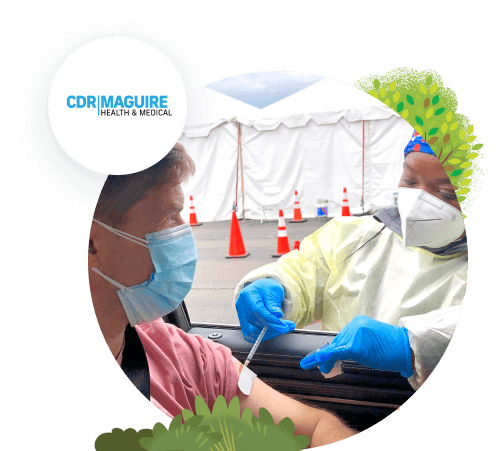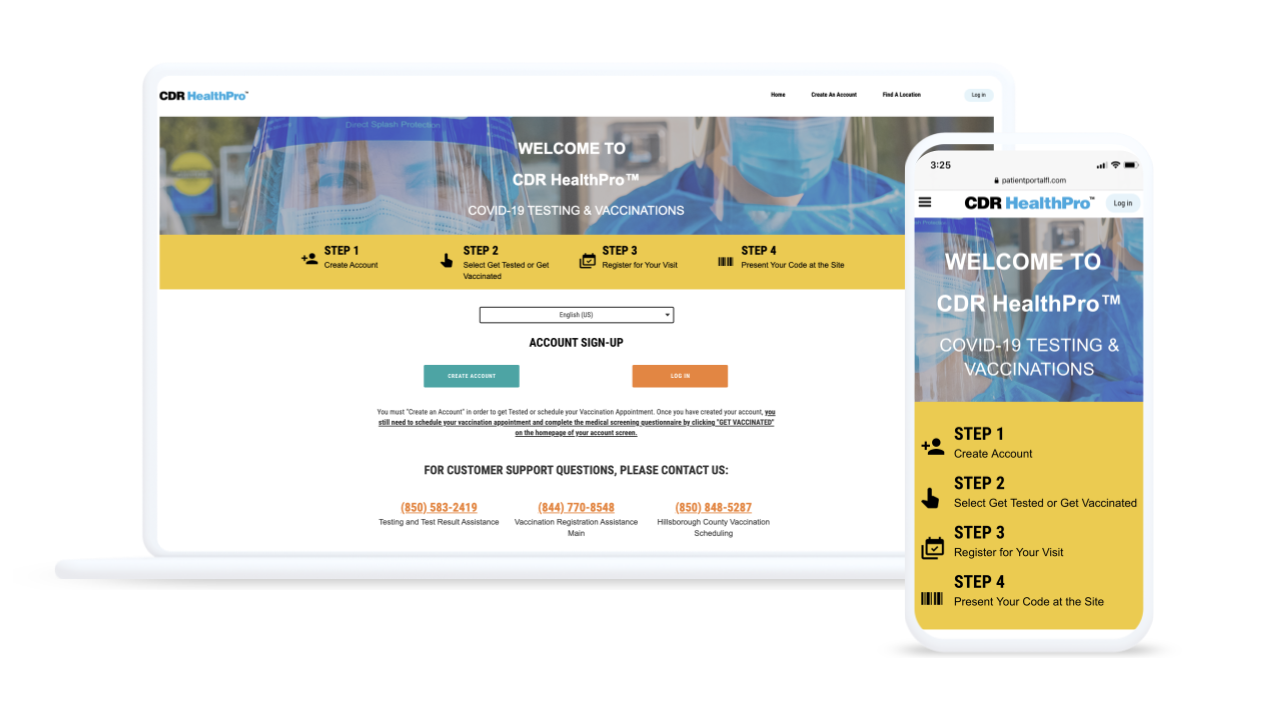DTRA’s Office of Small Business is a Trailblazer
CDR Maguire manages, automates, and connects mission-critical business processes on the cloud

“I will never forget how critical and dire the COVID-19 situation was back in January, February, March of 2020,” said Tina Vidal, Executive Vice President at CDR Maguire. “In those early days, one of our customers with the State of Florida needed a certain amount of body bags within 12 hours. We were able to find a supply of them. More than they needed, in fact. They ended up purchasing all of them anyway, and as they did they said to me ‘we’re never going to use all of these, but we're going to go ahead and stock up.' And two weeks later came back and asked me to double that order.”
CDR Maguire is a government contractor that got its start as an engineering firm and has now expanded its scope to include emergency management solutions, disaster health and medical services, consulting services, and more. The company manages over $2 billion in construction and over $10 billion in disaster recovery, making it one of the country’s leading enterprise resource planning experts — largely in fast-paced emergency response scenarios.
“A disaster, in general, is a project that happens without much time to plan. It's not like, say, building a bridge where a client puts out an RFP and you have years to plan for that. A hurricane just happens, an earthquake just happens, a wildfire just happens. And so, by nature, our team has to find a way to build proactive strategies into reactive patterns if we're going to be successful. The cloud helps us do that,” Vidal continued.
What to do when “all hands on deck” doesn't work.
Like many emergency response teams, CDR Maguire found itself in all hands on deck mindset with the onset of COVID-19. The company was contracted with multiple labs as well as departments and agencies across the State of Florida to build testing and processing services at a time when much was still unknown and supplies were scarce. This created some understandable challenges from a planning and logistics perspective. “When we run into this sort of complexity, we apply our #getitdone mantra. We start by breaking down the scenario and solving the first problem at hand, and that gets us moving in a certain direction. Then we solve the next problem, then the one after that...no complaining, no ‘I can’t.’ Everyone is onsite and there to help 24/7, and the more people you have working on it the faster it gets done,” said Vidal.
But COVID-19 has proven to be different from other disasters.
Adding more people wasn’t a viable option because Vidal couldn't risk putting big teams in war rooms together, or stand up the usual thousand-person call center. Furthermore, several employees who were essential staff onsite were in and out of quarantine after learning of potential exposures, making CDR Maguire's ability to react quickly to breaking news especially crucial. “If you didn't know you were positive and you were still manning the call center, you were infecting multiple other people. So, the ability to get information out to both our staff and the people they were helping — quickly, at scale — became really important,” said Vidal. “And whenever you have to do something at such a large scale, automation is key.”
CDR Maguire defines emergency enterprise resource planning in the cloud.

Patient portal:
Vidal and team started integrating processes from the multiple labs it was supporting into a single user interface on Experience Cloud. This meant that anytime a resident registered for a COVID-19 test at any given lab, their information was captured in a personalized profile within the same system of record, giving the state a holistic view of outbreak potential.
It also gave residents a consistent user experience regardless of which site they happened to visit for their test. “People can now visit one website, or call one phone number to get and/or print their results, which is faster and less stressful than the piecemeal approach we’ve seen elsewhere,” said Vidal.
Contact center:
Soon, CDR Maguire found that it was answering as many as 200,000 calls per day. The team added Service Cloud to deployment, giving the team the tools they needed to easily communicate with the volume of callers, quickly. “Integrated interactive voice response features, automated callbacks, SMS capabilities, email, and more enabled us to share test results with the patient as well as the state’s reporting system the second they came in from the labs,” Vidal continued. “There was just this huge volume of people looking for information so that they knew where to go for a test, if they could go to work, visit loved ones in the hospital, safely go home to their families at night, and so on.”
Platform-level services:
Shield was layered on, enabling CDR Maguire to add an additional layer of security to its platform.
Integrated reports and dashboards are also being leveraged, giving CDR Maguire an easy way to roll up current status, surface patterns, pinpoint catalysts, and make data-driven decisions on a daily basis.
Last but not least, it is mobile-ready, out-of-the-box. “Test sites open and close. We’ve seen popup test sites. Mobile testing clinics, similar to a Blood Moblie. So, we really needed the hardware component of this ERP system to be as handheld and as mobile as possible. We were able to do that on Salesforce - no custom coding required,” said Vidal.
Extended use case - vaccine management:
As COVID-19 vaccines started becoming a reality, Vidal and team added options for residents to schedule their vaccine appointments to the ERP, modeling the workflow after the testing design. Vaccine data is added to the same profile that holds any testing events, helping to ensure that the individual’s vaccine data is managed and tracked in one place.
ERP best practices
Real results have a big impact.
Since going live, Vidal and team have been encouraged by the ERP’s results, knowing what these numbers mean in terms of public health, safety, and overall well-being.
On the quantitative side, rapid test results are available in about 15 minutes. A text is sent out automatically to those who opted in, and a call is scheduled from the call center within the next 20 to 25 minutes. Ie: patients are receiving rapid test results in under 30 minutes. Polymerase chain reaction tests (think: nasal swab), the team is reporting test results in 16 hours on average for those coming from local labs, and 24 hours on average for those coming from out-of-state labs. In either scenario, the process is the same: once lab results are available, they automatically feed into the ERP, triggering a text message notification, email and, and phone call scheduling. To date, the ERP has managed millions of COVID-19 tests and supports 2 million registered patients, and that number is only growing as vaccine eligibility continues to expand.
By the numbers
Capacity and general performance
- CDR Maguire’s emergency ERP system supports 2 million registered profiles and counting
- Millions of COVID-19 tests have been conducted
- Rate of error reduced from 30% to less than 5%
Testing
- COVID-19 rapid test results are shared within 30 minutes
- PCR test results are shared between 16 and 24 hours
Vaccinations
- Vaccine appointments are booked at an average rate of 500 appointments per second
- Over 2 million vaccines have been administered
- Average vaccinations per day = 51,000
- Average check-in time = 4 minutes
- Average time onsite = 26 minutes
With respect to vaccinations, the system has been booking appointments at an average rate of 500 appointments per second and has been used to facilitate the administration of over 2 million vaccinations at the time of publication at a rate of approximately 51,000 per day. Once the patient arrives on site for their vaccination, the average check-in time is 4 minutes, and the total appointment is averaging 26 minutes including observation.
On the qualitative side, many of the processes that are behind the aforementioned numbers have been largely automated. Consent forms have been incorporated into the registration fields in the Experience Cloud portal when the patient books their testing or vaccination appointment, eliminating the need for manual data entry onsite. Drivers licenses or QR codes are scanned at check-in, freeing up onsite staff from having to enter name, date of birth, etc. “This not only reduces the amount of time patients have to spend on-site, but also reduces the rate of error. At the beginning of the pandemic, I can't tell you how many errors I saw because of accent barriers, language barriers, hand-writing, tired eyes that had read too many spreadsheets by the end of our long days, and so on. It caused a multitude of issues, including patients not being able to get their results because their date of birth didn't match or their name was misspelled,” said Vidal. “Since implementing our emergency ERP system, we've seen the error rate drop from around 30% to less than 5%.”
Vidal and team are also able to pull a wider variety of reports on a more frequent (often daily) basis, giving everyone better insights into the effectiveness of response efforts; how many vaccines have been administered, how sites are performing comparatively speaking, what staffing adjustments might be needed in order to maintain traffic flow, what resources — like tents, traffic cones, PPE — might be needed at which site, progress by demographic, and more.
“In the emergency management world, we have a saying: you can do things accurately, you can do them fast, or you can do them cheap. You only get to pick one in the face of a disaster,” said Vidal. “But the cloud gave us a way to deliver on all three, creating a turnkey system that has helped us be so much more effective in our COVID-19 response.”






